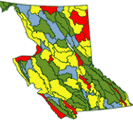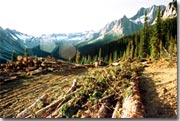|
|||||||||||||
The EnvironmentProtected Areas & Land Use Designations
The project area is virtually surrounded by existing or proposed parks and conservancies, but it is not in an existing or proposed park or conservancy. Following the East Kootenay Commission on Resources and the Environment (CORE) land use review, protected areas in the East Kootenay were substantially expanded and the upper part of the Toby Creek drainage, above the confluence with Jumbo Creek, up to Earl Grey Pass, was included in the Purcell Wilderness Conservancy. The Purcell Wilderness Conservancy was increased with the addition of 34,300 hectares for a total of 198,183 hectares. The East Kootenays now have 16.5% of the land base in protected areas and conservancies. The Provincial news releases of April 10, 1995 and of August 9, 1995 and the B.C. Land Use Coordination Office confirmed that the Jumbo Creek drainage is not in a conservation or protected area and may be considered for a resort of the type proposed. At the CORE land use designation table a large majority (18 out of 22 sectors) requested that the area be specifically designated for Integrated Use. At the conclusion of the CORE process it was designated under Special Management with Commercial Tourism (including resorts) as the most important recognized value. This was unique among the Special Management Zones. This project was specifically mentioned in the CORE report as being approvable following the Environmental Assessment Act review process.* The Jumbo Creek Valley has been subjected to mining exploration, mining, forest fires, and extensive logging for a century. Logging, mostly to cut ski runs for heli-skiers, started again in the summer of 1991 and continued in upper Jumbo Creek and Leona Creek, with an expanded and improved logging road that may now be used by regular cars to the proposed resort base. The Valley is the one that has had the greatest use both for industry and recreation in the region. The Jumbo Creek Valley is not pristine and it has never been proposed for a conservancy or protected designation. * The CORE Commission's recommendation on Jumbo Creek can be downloaded here in PDF format (184K). Environmental ConsiderationsIt is intended that the project will make use of the most advanced means of environmental protection and will compare favourably with the best developments in the National Parks, both in terms of style and in terms of a superior environmental response to a sustainable natural setting. It is, of course, in the best interest of both the public and the Proponent, that the project be designed, built, and operated according to the best sustainability principles.
Many studies have been underway since 1990 and the information gathered from these studies has been used to refine the project's design concept. One issue that has arisen is that of potential loss of Grizzly Bear habitat. However, a comparison with other parts of the Province (with the exception of Vancouver Island) confirms that nowhere else in the Province is it possible to find a more sustainable site for a mountain resort, as this seems to be a region and a location with the least potential impact on the future of Grizzly Bear populations, at the southern end of their still huge territory, which spans almost a quarter of the continent, from Yellowstone National Park to Alaska. The project is designed to be small, contained island in a reclaimed valley, where the habitat will be enhanced.
A study on Grizzly Bear populations in the Central Purcells, commissioned jointly with the Environmental Assessment Office, confirms the Proponents' findings through the previous years of environmental studies. Of the 33 individual Grizzlies identified from hair samples collected in the 1998 "Grizzly Bear Population Survey in the Central Purcell Mountains", covering an area of 4,000 square kilometres, only 2 Grizzly Bear hair samples were collected in the Jumbo Valley, versus 31 in the other drainages. Grizzly Bears were not found within 1 kilometer of main valley bottom roads, even though 26% of the capture sites were located near these roads. The proposed resort is at the end of the existing road. In the last fifty years, the Jumbo Creek Valley has been the most intensely utilized valley among the nearby drainages for both primary resources and recreation. The proposed project is on a former sawmill site, north of the Leona Creek drainage, which borders the enlarged protected area of the Purcell Conservancy. This is an existing and future sizeable sanctuary for wildlife, still connected in a variety of ways, particularly west of Glacier Creek, with the bear territory that spans from Yellowstone and Glacier National Park in the United States to the Canadian North and Alaska. The project plans have been improved in order not to risk breaking that connectivity and to be insignificant as an intrusion. However, it is noteworthy that hunting, including Grizzly Bear hunting, is still permitted not just within Jumbo, but also in the entire Purcell Wilderness Conservancy.
Some people are concerned that another pristine valley would be lost, but this is erroneous for a number of reasons: a) the Valley is not pristine. It has had substantial human activity including logging, mining, exploration, skiing, snowmobiling, hiking and hunting for over five decades. The resort is proposed for the site that was previously utilized for a sawmill. b) the Valley is the most accessible and accessed valley in the region; the one with the best road access and with the shortest distance from existing development, with Panorama 20 km (12.5 miles) away and Invermere 38 km (24 miles) away from the Jumbo Valley entrance at the Mineral King Mine. c) the development is planned to be tightly contained and will return most of the Valley to a natural configuration. The Proponent is encouraged by the fact that the conclusion of the Environmental Assessment Act process including over a decade's worth of impact studies and reviews is quite positive, and that the creation of a sustainable project as is proposed is possible. Finally, the Kootenay Region and British Columbia have an extremely large representation of pristine valleys with the same ecosystems. The huge Purcell Wilderness Conservancy is an example. Where ecosystems are being lost and becoming underrepresented is in the lower drainages and in the base valleys, in the "front-country" where development sprawl is a real threat, not in upper Jumbo Creek with a well contained and properly planned resort. In this respect it is not logical to propose that more development occur in the so-called "front country." If mountains can be shown to the public, it must be through contained and well-planned resorts that will constitute islands of sustainable development in a restored natural environment. This is an ideally managed response to the environmental challenge as opposed to the indiscriminate motorized and non-motorized access overtaking the interior and the backcountry and the continuous sprawl in the main valleys, or "front country." NEXT » Tourism Trends
|
|||||||||||||
|
Project Outline •
Gallery •
Documents Copyright © 1996 - 2006, Glacier Resorts Ltd. All rights reserved. |
|||||||||||||


